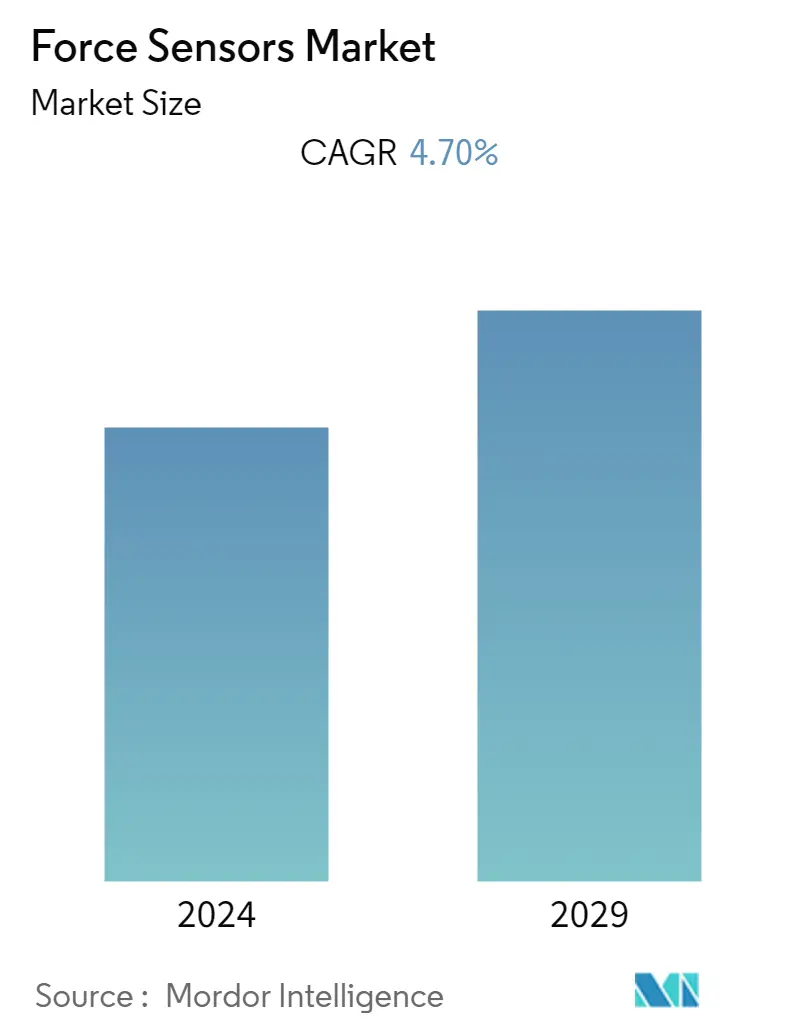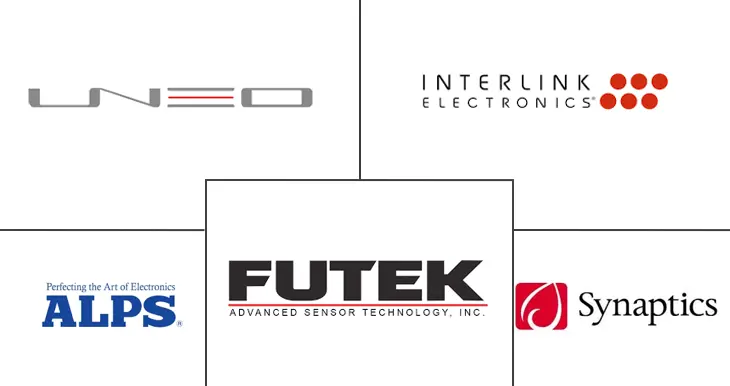Market Size of Force Sensors Industry

| Study Period | 2019 - 2029 |
| Base Year For Estimation | 2023 |
| CAGR | 4.70 % |
| Fastest Growing Market | Asia-Pacific |
| Largest Market | North America |
| Market Concentration | Medium |
Major Players
*Disclaimer: Major Players sorted in no particular order |
Force Sensors Market Analysis
The force sensors market is expected to register a CAGR of 4.7% over the forecast period. Force sensors have become critical features in industrial robots by enabling them to be task agnostic and safely operate alongside humans. These sensors have improved the monitoring and management of networked embedded systems. The adoption of automation has transformed the global landscape, as these sensors have become critical to all automated equipment, offering accuracy and precision in all operations.
- Force sensing makes surfaces more intuitive, and the displays enable user experience designers to simplify and improve the control surface layouts on many appliances. It has allowed designers to seamlessly integrate force sensors into new designs by exploring a new generation of appliance user interfaces.
- Force sensors are frequently installed to track the force experienced by vehicle parts such as axle beams and dampers to avoid fatigue failure, particularly in heavy automotive vehicles such as construction trucks and mining vehicles, where overloading or unexpected stress levels may result in higher maintenance costs.
- Furthermore, the increasing safety regulations and rapidly rising adoption of advanced driver assistance systems (ADAS), which alert drivers based on several parameters, are expected to drive the demand for force sensors over the forecast period.
- Moreover, industrial robots are more adaptable, intelligent, and autonomous. The development of force sensor technologies is driving the advancement of robots. Force sensors can detect different forces when applied to the robot's wrist or end-of-arm tooling. The market for force sensors is expanding due to cheap production costs, technical advancements, rising industrial robot demand, the creation of force-measuring medical devices, and expansion and innovation in the industrial sector.
- Additionally, the demand from automotive, consumer electronics, and healthcare industries has increased post-pandemic situation as the government released the restriction and increased demand from the consumer for automotive and consumer electronics, which will further be expected to add growth for the force sensor market. After the COVID-19 pandemic, the global force sensor market showed steady growth due to its demand for various applications such as electric vehicles, autonomous vehicles, smartphones, and smart healthcare devices. Such applications will boost the market in the near future.
- The market's current force sensor product portfolio is relatively standardized in product offerings. Although the market has the potential to cater to a plethora of applications, the offerings of the market players are pretty limited. However, the market is witnessing the introduction of customized force sensor products for specific original equipment manufacturing (OEM) needs.
- However, the significant restraint in the market is the fluctuating demands of the end-user industry. Need is not fixed in the end-user sector and is a challenge to production schedules. Rejection rates at manufacturing facilities are due to damage or poor sensitivity, reducing overall production capacity. Additionally, rapidly changing requirements in the automotive, medical, and aerospace sectors drive the need for more accurate measurements.
Force Sensors Industry Segmentation
Force sensors are devices that transform external force into digital signals, allowing the parent system to detect, measure, and monitor the quantity and direction of applied force. They have become essential elements in industrial robots, allowing them to be job agnostic and work safely alongside humans. These sensors have improved networked embedded system monitoring and administration.
The force sensors market is segmented by type (tension force sensors, compression force sensors, and tension and compression force sensors), End-user industry (healthcare, industrial manufacturing, automotive, aerospace and defense, consumer electronics, and other end-user industries), and geography. The market sizes and forecasts are provided in terms of value (USD million) for all the above segments.
| Type | |
| Tension Force Sensors | |
| Compression Force Sensors | |
| Tension and Compression Force Sensors |
| End-user Industry | |
| Healthcare | |
| Industrial Manufacturing | |
| Automotive | |
| Aerospace and Defense | |
| Consumer Electronics | |
| Other End-user Industries |
| Geography | |
| North America | |
| Europe | |
| Asia-Pacific | |
| Latin America | |
| Middle East and Africa |
Force Sensors Market Size Summary
The force sensors market is poised for steady growth, driven by their integral role in enhancing automation and safety across various industries. These sensors are crucial in industrial robotics, enabling machines to operate safely alongside humans by providing precise force measurements. Their application extends to automotive, consumer electronics, and healthcare sectors, where they contribute to the development of advanced driver assistance systems and intuitive user interfaces. The post-pandemic recovery has further fueled demand, particularly in electric and autonomous vehicles, smartphones, and smart healthcare devices. Despite the market's potential, challenges such as fluctuating end-user demands and manufacturing sensitivities pose constraints, yet the introduction of customized sensor solutions for specific OEM needs offers a pathway for growth.
Regionally, the Asia-Pacific market is experiencing significant expansion due to rising automotive standards and technological advancements, particularly in countries like India and China. The region's robust industrial manufacturing and high domestic consumption of sensor-equipped products make it a lucrative market. The automotive industry's growth, coupled with government initiatives to promote electric and hybrid vehicles, is expected to drive further demand for force sensors. The market remains moderately fragmented, with key players like Sensata Technologies and Alps Electric Co. Ltd leading innovations. Recent developments, such as Sensata's Brake Pedal Force Sensor and Forsentek's advanced load cells, highlight ongoing advancements in sensor technology, reinforcing the market's growth trajectory.
Force Sensors Market Size - Table of Contents
-
1. MARKET DYNAMICS
-
1.1 Market Overview
-
1.2 Market Drivers
-
1.2.1 Innovation and Development in the Consumer Electronics Sector
-
1.2.2 Surging Demand in the Automotive Sector
-
-
1.3 Market Restraints
-
1.3.1 Fluctuating Market Demands and Customization Issues
-
-
1.4 Value Chain/Supply Chain Analysis
-
1.5 Industry Attractiveness - Porter's Five Forces Analysis
-
1.5.1 Threat of New Entrants
-
1.5.2 Bargaining Power of Buyers
-
1.5.3 Bargaining Power of Suppliers
-
1.5.4 Threat of Substitute Products
-
1.5.5 Intensity of Competitive Rivalry
-
-
1.6 Assessment of COVID-19 Impact on the Industry
-
-
2. MARKET SEGMENTATION
-
2.1 Type
-
2.1.1 Tension Force Sensors
-
2.1.2 Compression Force Sensors
-
2.1.3 Tension and Compression Force Sensors
-
-
2.2 End-user Industry
-
2.2.1 Healthcare
-
2.2.2 Industrial Manufacturing
-
2.2.3 Automotive
-
2.2.4 Aerospace and Defense
-
2.2.5 Consumer Electronics
-
2.2.6 Other End-user Industries
-
-
2.3 Geography
-
2.3.1 North America
-
2.3.2 Europe
-
2.3.3 Asia-Pacific
-
2.3.4 Latin America
-
2.3.5 Middle East and Africa
-
-
Force Sensors Market Size FAQs
What is the current Force Sensors Market size?
The Force Sensors Market is projected to register a CAGR of 4.70% during the forecast period (2024-2029)
Who are the key players in Force Sensors Market?
Alps Electric Co. Ltd, Synaptics Inc., Interlink Electronics Inc., Uneo Inc. and Futek Advanced Sensor Technology Inc. are the major companies operating in the Force Sensors Market.

